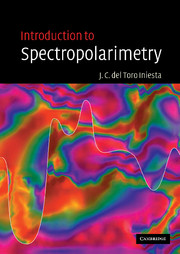Book contents
- Frontmatter
- Contents
- Preface
- Acknowledgements
- 1 Historical introduction
- 2 A review of some basic concepts
- 3 The polarization properties of quasi-monochromatic light
- 4 Linear optical systems acting on polarized light
- 5 Solar polarimetry
- 6 Absorption and dispersion
- 7 The radiative transfer equation
- 8 The RTE in the presence of a magnetic field
- 9 Solving the radiative transfer equation
- 10 Stokes spectrum diagnostics
- 11 Inversion of the RTE
- Index
8 - The RTE in the presence of a magnetic field
Published online by Cambridge University Press: 11 August 2009
- Frontmatter
- Contents
- Preface
- Acknowledgements
- 1 Historical introduction
- 2 A review of some basic concepts
- 3 The polarization properties of quasi-monochromatic light
- 4 Linear optical systems acting on polarized light
- 5 Solar polarimetry
- 6 Absorption and dispersion
- 7 The radiative transfer equation
- 8 The RTE in the presence of a magnetic field
- 9 Solving the radiative transfer equation
- 10 Stokes spectrum diagnostics
- 11 Inversion of the RTE
- Index
Summary
Magnetic fields are to astrophysics as sex is to psychology.
—H. C. van de Hulst, 1989.Now that we have formulated the general RTE for a stratified anisotropic medium in LTE, let us particularize our study to the case of an atomic vapor permeated by a magnetic field, B. For convenience, we shall consider the medium to be isotropic in the absence of an “external” magnetic field. It is thus B that establishes the optical anisotropy by introducing a “preferential” direction.
In order to understand the basic concepts, we start again with the simple Lorentz model of the electron as in Chapter 6 (this time introducing the Lorentz force in the dynamical balance). In this way, the so-called “normal” Zeeman effect gets fully explained. The “anomalous” Zeeman effect, however, needs further results from quantum mechanics that will be summarized later. As the reader may already have realized from the historical introduction, this procedure conforms with historical developments. As in many other branches of physics, a chronological treatment helps in comprehension, although it is not strictly necessary.
In this chapter, we shall see that a single (unpolarized) spectral line in the absence of a magnetic field splits into various Zeeman components, each with a distinct state of polarization that may, of course, vary along the profile.
The Lorentz model of the electron
Let us resume our discussion of Section 6.2 on the Lorentz model.
- Type
- Chapter
- Information
- Introduction to Spectropolarimetry , pp. 121 - 148Publisher: Cambridge University PressPrint publication year: 2003



